| |
Cryptocoryne striolata Engler |
Cryptocoryne striolata is rather well known. The plants is widespread in
Borneo and is collected (and shipped) many times. But it is nearly impossible to grow this
very nice plant in an aquarium. Even in emersed culture this one is not easy to grow for a
long time. This web page deals mainly on the variation in this species. It proves to be
very difficult to recognize not flowering plants because of the variation in the leaves.
Click on the picture to get the full image (ca. 50 kB) |
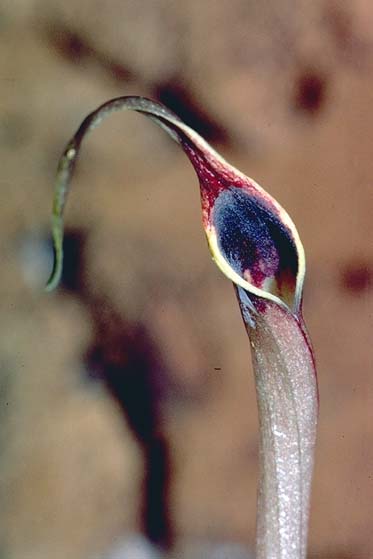 |
Typical inflorescence of Cryptocoryne
striolata. Note the very slender tail of the limb. A collar lacks.
coll. hort., cult B183 |
|
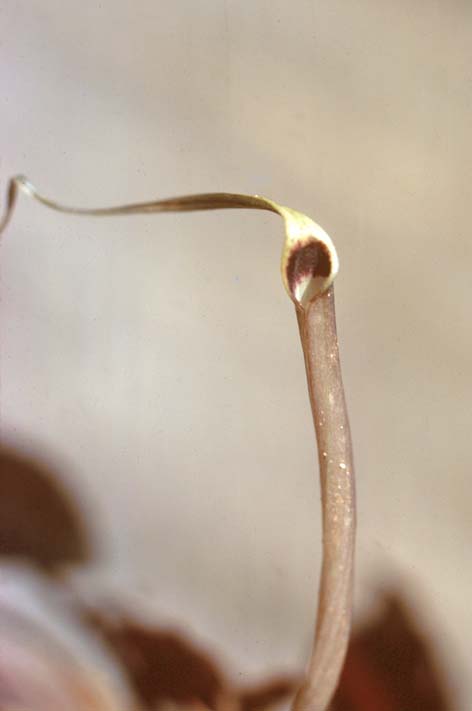 |
The limb may be yellowish. The throat is almost
black to purple red or may be red dotted.
coll.& cult. NJ78-1
photo Jacobsen
|
|
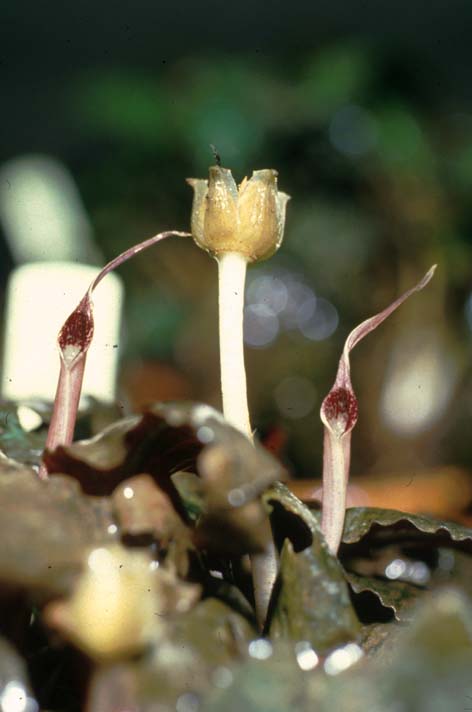 |
Fresh imported specimen flowering and fruiting
in Zurich (CH).
coll.& cult CK74-78.
photo Kettner |
|
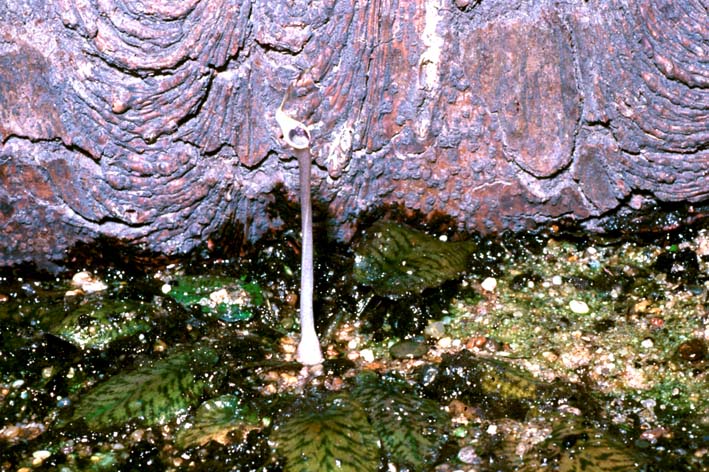 |
De Wit cultivated this specimen of C.
striolata in the Wageningen hothouses (ca 1970).
coll. H. Ong?, cult. WAG
photo de Wit
|
|
| |
|
|
|
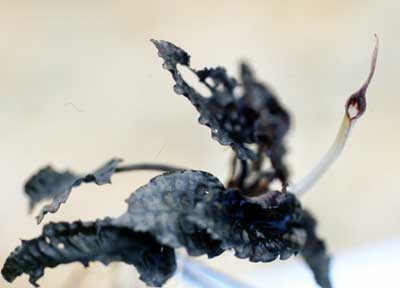 |
1999, Yuji Sasaki collected C. striolata in Sarawak. Note the dark, almost black bullated leaves.
coll. TB2
photo Sasaki
|
|
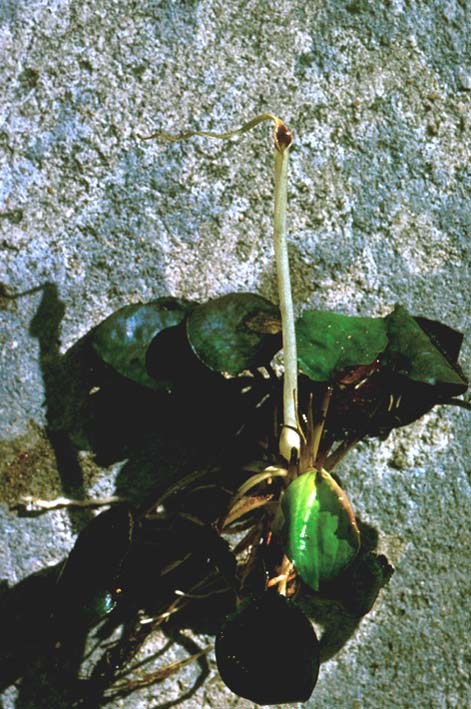 |
Jacobsen collected this striolata with green even
leaves.
coll. NJ78-49
photo Jacobsen
|
|
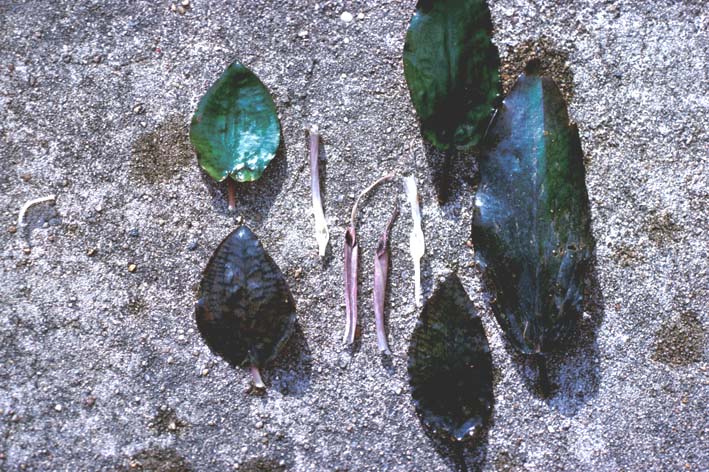 |
Variation in the leaves from plants collected
very close to each other.
coll. NJ78-1 and 78-3.
photo Jacobsen
|
|
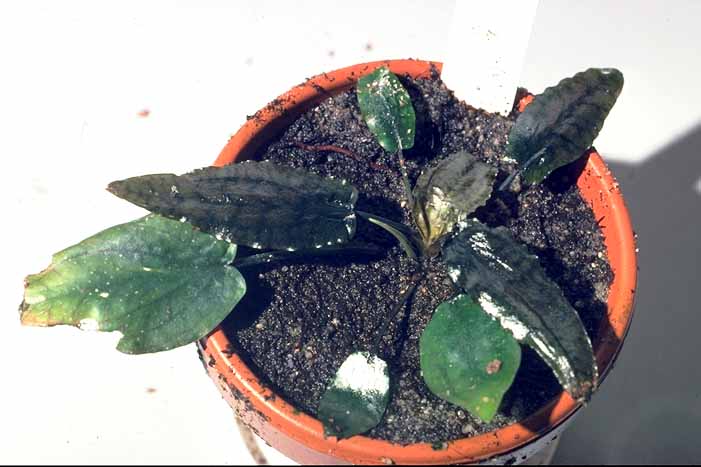 |
Also in culture, the leaves of C. striolata are variable. The older (green) leaves are the 'import' leaves.
coll. hort., cult. B183
|
|
| |
|
|
|
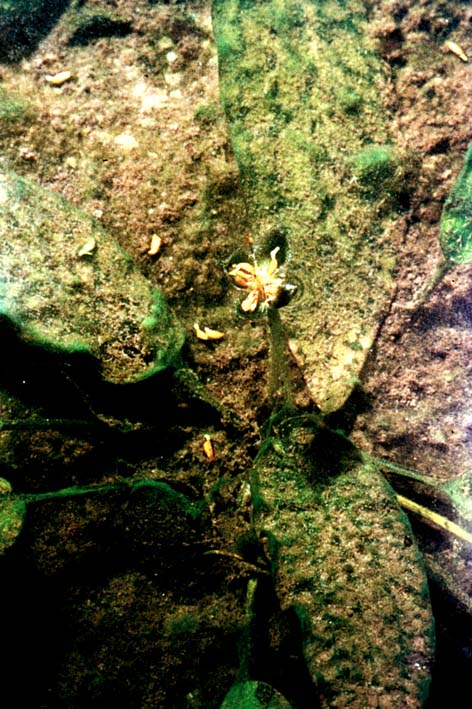 |
Cultivated specimen of C. striolata ( C.
gracilis ). Note the long, bullated leaves. See the the herbarium sheet below.
coll.H.Ong?, cult.de Wit 35690
photo de Wit
|
|
 |
The older leaves almost black with the young
leaves coming out brownish.
coll. CK s.n.
photo Kettner
|
|
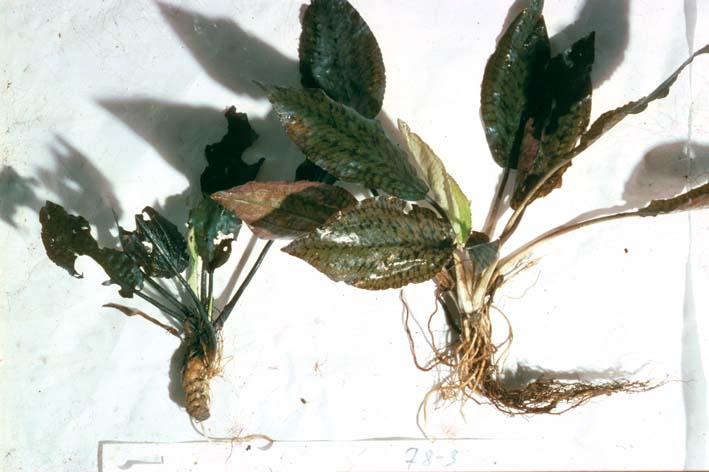 |
An even leaved specimen with distinct striping
on the leaves.
Coll. NJ 78-3
photo Jacobsen
|
|
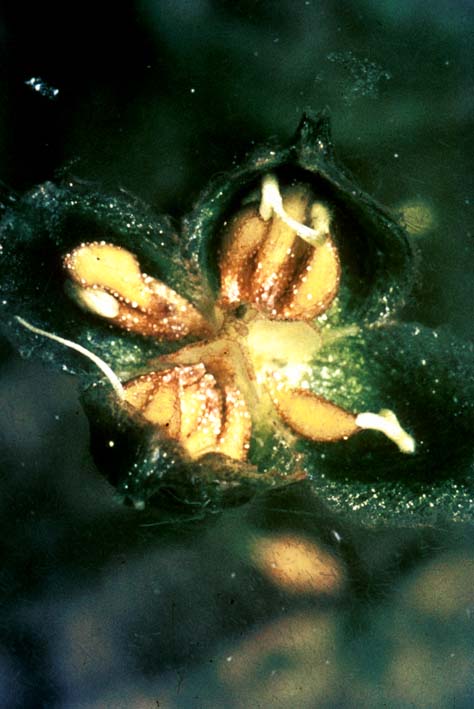 |
When the fruit (syncarpium) opens, the seeds
will germinate immediately. Note the only 4 parts of the fruit.
coll. H.Ong?, cult. de Wit 35692
photo de Wit |
|
| |
|
|
|
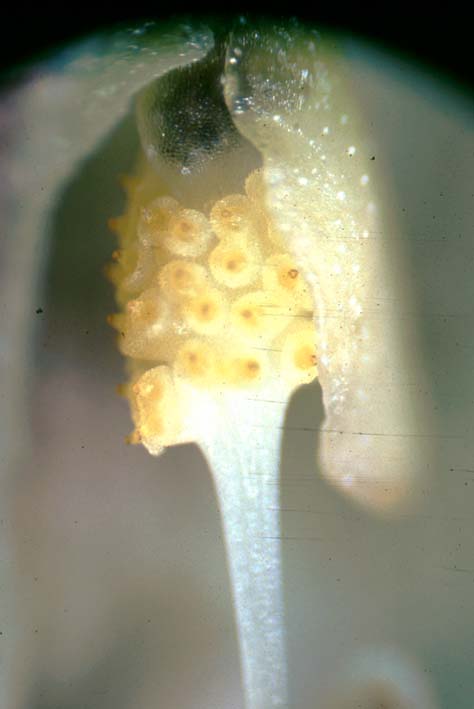 |
Male flowers of C. striolata. The
appendix (just above the flowers) is rather dark in this specimen.
coll. hort., cult B183 |
|
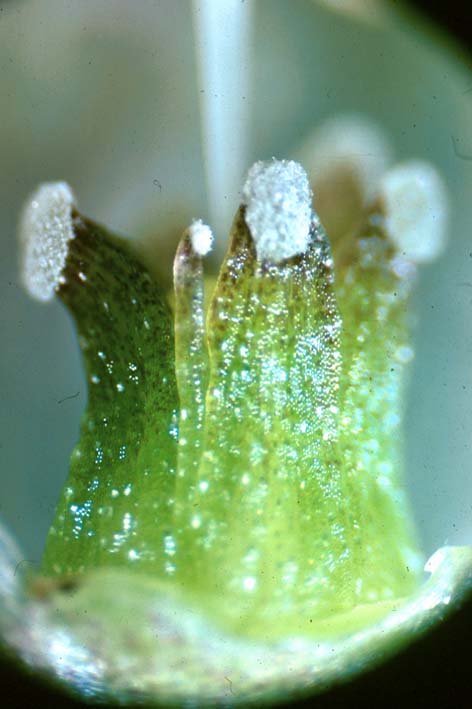 |
Female flowers of C. striolata. They
are not as well developed as in the plant at right.
coll. hort., cult B183
|
|
 |
The spadix is rather short in this
inflorescence. Note the red spots on the valve.
coll. TB2.
photo Sasaki |
|
 |
The herbarium sheet Pursegrove collected
in 1956, which de Wit used for his description of C. gracilis.
coll. Pursegrove 5361
herbarium Singapore |
|
| |
|
|
|
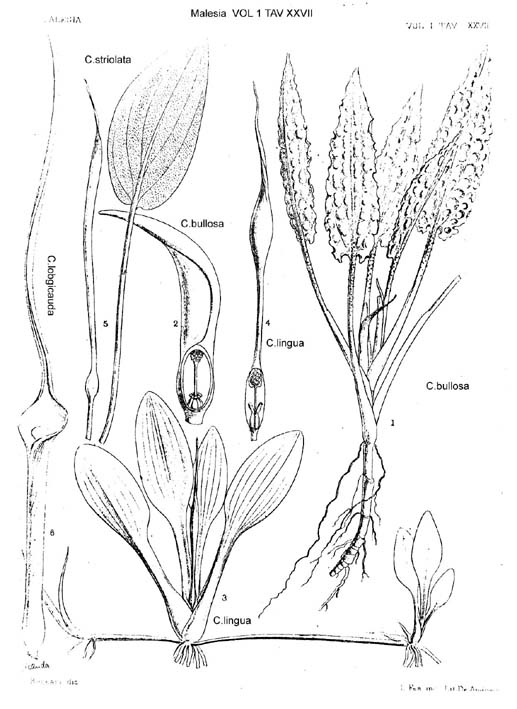 |
Beccari visited Sarawak in 1878. Plate XXVII in Beccari 1882 with top left C.
striolata |
|
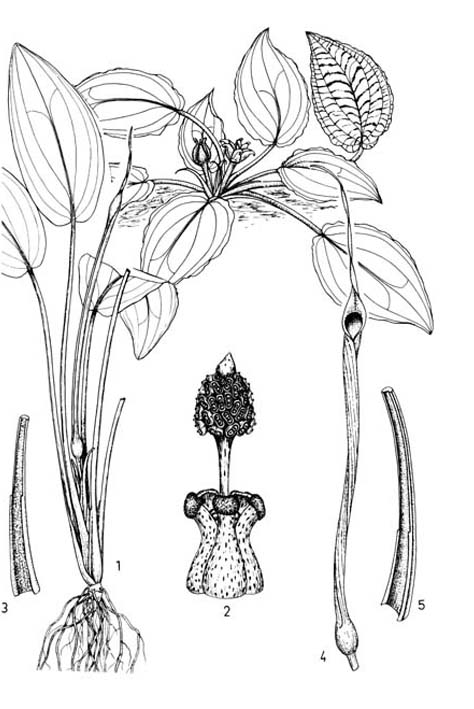 |
Drawing of C. striolata var. gracilis and C. striolata var. ongii (de Wit 1990)
drawing Ike Zewald
|
|
 |
Drawing of C. striolata var. gracilis (de Wit 1990).
drawing Ike Zewald |
|
 |
Known distribution of C. striolata in
Borneo. As the Southern and Eastern parts are less investigated, the distribution may be
larger. |
|
| |
|
|
|
Cryptocoryne striolata is characterized by its slender spathe which ends with
a long tailed, narrow limb. The limb is even and has a yellow to redpurple color. The
throat is distinct colored with a red zone, sometimes downwards with red spots. There is
no collar present. De Wit distinguishes three var.'s based on the variation in the color
of the limb. It proves not to be a very good distinction for that and is not followed. On
the other hand, variation in the leaves, both in nature and - in the same material - in
culture, make it impossible to put any decision about the identity of not flowering
plants. This situation is not unusual in Cryptocoryne.
The chromosome count for C. striolata is 2n=20. This is quite remarkable for it
is only shared with C. keei and C. hudoroi, two other species from
Borneo. The spathes are rather close, the leaves of both other species are rather long
with a strong bullated surface (Bogner 1989).
Updated January 2000 |
Literature.
- Arends, J.C., Bastmeijer, J.D. & Jacobsen, N.,1982. Chromosome numbers and taxonomy
in Cryptocoryne (Araceae).II. Nord.J.Bot. 2 : 453-463.
- Beccari, O., 1882. Aracee della Malesia e della Papuasia raccolte da O.Beccari..Malesia 1 : 296-300, Plate 27-28. (Document service)
- Bogner, J., 1989. Cryptocoryne hudoroi Bogner et Jacobsen. Aqua-Planta 1-89 : 12-16.
- Engler, A., 1879. Cryptocoryne Fischer. Bull.Soc.Tosc.Ortic. 4 : 301-302. (Document service)
- Engler, A., 1920. (Cryptocoryne in:) Das Pflanzenreich IV.23.F. Araceae -
Aroideae : 232-249, Leipzig (Document service)
- Horst, K., 1982. Sind die Cryptocorynen aus Borneo für Aquarien geeignet ? III.
Aqua-Planta 1-82 : 3-5.
- Horst, K., 1986. Pflanzen im Aquarium. Ulmer, Stuttgart.
- Jacobsen, N., 1982.Cryptocoryne from Borneo. Meded. WAP 3 : 61-76.
- Jacobsen, N., 1982. Cryptocorynen. Alfred Kernen Verlag, Stuttgart.
- Jacobsen, N., 1984. Cryptocoryne from Borneo – postscript. Meded. WAP 5 : 38-43.
- Jacobsen, N., 1985. The Cryptocoryne (Araceae) of Borneo. Nord.J.Bot. 5 : 31-50.
- Jacobsen, N., 1986. Deterioration of the habitats of the Cryptocoryne species.
Symp.Bedreiging van het aquatisch milieu, Ludwigia, Wageningen : 33.
- Kasselmann, C., 1995. Aquarienpflanzen. Ulmer, Stuttgart.
- Merrill, E.D., 1921. A Bibliographic Enumeration of Bornean Plants. Journal of the Straits
Branch of the Royal Asiatic Society : 106-109.
- Rataj, K., 1975. Revision of the genus Cryptocoryne Fischer. Studie CSAV, c.3.Praha.
- Ridley, H.N., 1905. The Aroids of Borneo. J.Str.Br.Roy.As.Soc. 44 : 169-171.
- Sadilek, V., 1979. Unklarheiten bei Cryptocoryne cordata. DATZ 32/2 : 56-58.
- Schulze, J., 1971. Cryptocorynen aus Sarawak I-IV. DATZ 24 : 230-233, 267-270, 303-306,
- Tomey, W.A., 1978. Twee Cryptocorynen van Upper Sadong in Sarawak, Noord Borneo. Het
Aquarium 48(11) : 287-288.
- Wit, H.C.D.de, 1970. A key to the species of Cryptocoryne Fish.ex Wydl.(Araceae).
Misc.papers LH Wageningen 6 : 257-280.
- Wit, H.C.D.de, 1990. Aquarienpflanzen, 2. Auflage. Ulmer, Stuttgart. ISBN 3-8001-7185-6.
|
|
|
|
 |
|
|